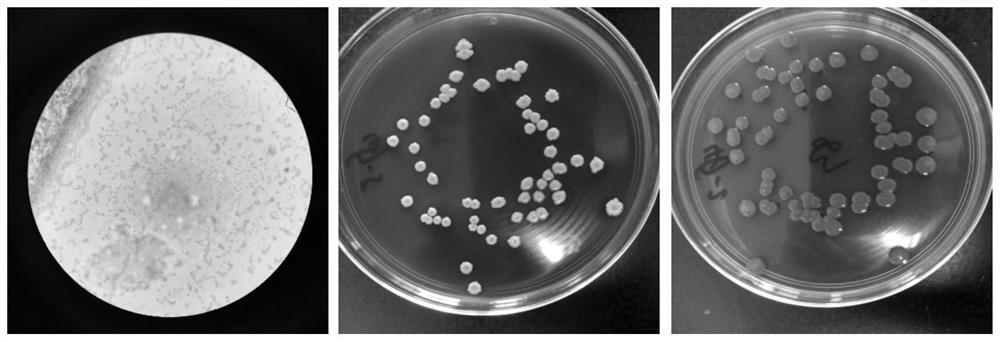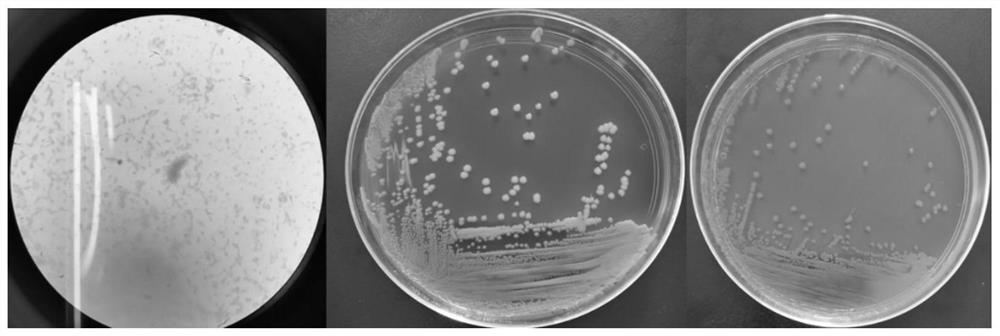Standard strain of Yersinia enterocolitica containing specific molecular targets and its detection and application
A technology for Yersinia and enterocolitis, applied in the field of microbiological testing, can solve the problems of not reflecting the contamination and transmission of the bacteria well, achieve clear virulence genes and drug resistance spectrum, biotype and serum well-defined effect
- Summary
- Abstract
- Description
- Claims
- Application Information
AI Technical Summary
Problems solved by technology
Method used
Image
Examples
Embodiment 1
[0032] Example 1 Isolation and cultivation of Yersinia enterocolitica bacterial strain
[0033] The collected food samples were thoroughly shredded under aseptic conditions, 25g of the sample was weighed and diluted 10 times, then enriched with PBS, cultured by shaking at 22°C-25°C for 2-3 days or standing for 5 days. After 20 seconds of alkali treatment (0.5 mL enrichment solution + 4.5 mL KOH), inoculate on CIN agar and incubate at 30°C for 24-48 hours. Pick five typical colonies and inoculate them on nutrient agar, and culture them at 30°C for 24 hours. Under sterile conditions, add the bacterial solution into a glycerol tube with a final concentration of 25%, and store in a -80°C refrigerator. Purified colonies are ready for subsequent screening experiments as well as biochemical identification and biotyping.
Embodiment 2
[0034] Example 2 Physiological and biochemical characteristics and serotype analysis of Yersinia enterocolitica standard strain
[0035] Modified Kirschner's double sugar test: Pick 3 to 5 suspicious colonies isolated and inoculate them on modified Kirschner's double sugar iron agar respectively. When inoculating, first draw a line on the slope, and then puncture the bottom layer, at 26°C±1°C After culturing for 24 hours, further biochemical identification was carried out on the cultures whose slopes and bottoms turned yellow and did not produce gas.
[0036] Colony morphology: using improved Y plate culture, the colony morphology of Yersinia enterocolitica standard strain is a round, pink colony with bile precipitation rings on the edge (results such as Figure 1-3 ).
[0037] Urease test and kinetic observation: Pick up a full ring of suspicious cultures obtained from the modified Klebsonian disaccharide test with an inoculation loop and inoculate them into urea medium. ...
Embodiment 3
[0048] Example 3 Carrying characteristics of virulence factors of Yersinia enterocolitica standard strain
[0049] The virulence genes carried by the strains were identified by PCR. The primers used were synthesized by Shanghai Sangon Biotechnology Co., Ltd. (see Table 4 for primer sequences). PCR amplification system (25 μL) includes: 2×Ferment PCR mix, 12.5 μL; 0.4 μM upstream and downstream primers; ddH 2 O, 8.5 μL and genomic DNA, 2 μL. 8-10 μL of PCR products were loaded on 1.5% agarose gel for electrophoresis separation (130V, 35 min), using 2000pb DNA Marker.
[0050] Table 4: Primer sequences and amplified fragments used in the detection of Yersinia enterocolitica virulence genes.
[0051]
[0052]
[0053] The virulence genes carried by the standard strain of Yersinia enterocolitica are as follows:
[0054] The virulence genes carried by the standard strain GDMCC 60852 are: ystB-ymoA-fes-sat-inv-hrep-fepA-fepD-myfA.
[0055] The virulence genes carried by...
PUM
 Login to View More
Login to View More Abstract
Description
Claims
Application Information
 Login to View More
Login to View More - R&D
- Intellectual Property
- Life Sciences
- Materials
- Tech Scout
- Unparalleled Data Quality
- Higher Quality Content
- 60% Fewer Hallucinations
Browse by: Latest US Patents, China's latest patents, Technical Efficacy Thesaurus, Application Domain, Technology Topic, Popular Technical Reports.
© 2025 PatSnap. All rights reserved.Legal|Privacy policy|Modern Slavery Act Transparency Statement|Sitemap|About US| Contact US: help@patsnap.com



